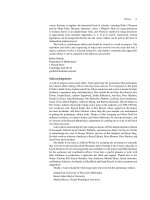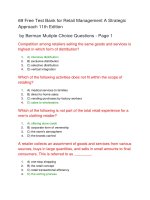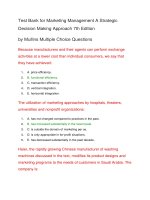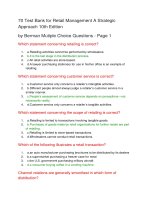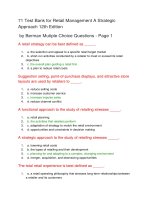128 test bank for essentials of marketing 14th edition part 2
Bạn đang xem bản rút gọn của tài liệu. Xem và tải ngay bản đầy đủ của tài liệu tại đây (162.34 KB, 32 trang )
128 Test Bank for Essentials of Marketing 14th Edition
Part 2
by Perreault Multiple Choice Questions - Page 1
Which of the following is the BEST example of management
thinking during the "production era"?
1.
A. "The more we advertise a product, the more we can sell."
2.
B. "We need to increase our sales effort-to sell what we can produce."
3.
C. "If we can produce it, customers will buy it."
4.
D. "We need to be selective and produce what customers want."
5.
E. "The lower we price a product, the more we can sell."
When marketing people do long-range planning and the whole
company is guided by the "marketing concept," the company has
entered the ______________ era.
1.
A. production
2.
B. customer satisfaction
3.
C. marketing company
4.
D. consumerism
5.
E. marketing department
The text considers five "eras" of marketing evolution. These five
eras in their logical order are:
1.
A. Simple trade, production, sales, marketing company, marketing department
2.
B. Subsistence, production, sales, entrepreneurial, marketing company
3.
C. Simple trade, production, sales, marketing department, international
trading
4.
D. Simple trade, production, sales, entrepreneurial, marketing company
5.
E. Simple trade, production, sales, marketing department, marketing company
During the sales era
1.
A. families traded or sold their surplus output to local distributors.
2.
B. characteristic management thinking said, "If we can make it, it will sell."
3.
C. all marketing activities were brought under the control of one department.
4.
D. increased competition made firms focus on winning customers.
5.
E. marketing people did both short-run and long-run marketing planning.
The text discusses the evolution of business through five "eras."
Which of the following is NOT one of these eras?
1.
A. Simple trade era
2.
B. Sales era
3.
C. Facilitator era
4.
D. Marketing department era
5.
E. Production era
The main difference between the "marketing department era" and
the "marketing company era" is:
1.
A. more emphasis on selling and advertising in the marketing department era.
2.
B. whether the president of the firm has a background in marketing.
3.
C. more emphasis on short-run planning in the marketing company era.
4.
D. whether the whole company is customer-oriented.
5.
E. There is no difference.
The economic freedom provided within a market-directed economy
produces the greatest number of:
1.
A. government planners
2.
B. government regulations
3.
C. entrepreneurs and innovators
4.
D. military-oriented purchases
5.
E. trade restrictions
The _________________ era is a time when a company
emphasizes selling because of the increased competition in the
external environment.
1.
A. supply
2.
B. demand
3.
C. production
4.
D. marketing
5.
E. sales
Myra Martinez was just named Treasure Island, Inc.'s "marketing
manager"-with responsibilities for short-run policy planning of the
firm's advertising, sales, marketing research, purchasing, and
distribution efforts. Apparently, Treasure Island is operating in the
______________ era.
1.
A. market-oriented
2.
B. production
3.
C. marketing department
4.
D. marketing company
5.
E. sales
Which of the following is LEAST LIKELY to be a government role in
a market-directed economy?
1.
A. To set rules to protect individual rights and freedom.
2.
B. To supervise the economy.
3.
4.
C. To provide things such as mass transportation and highways, national
defense, police and fire protection, and public health services.
D. To control interest rates and the supply of money.
5.
E. To determine prices-and thereby allocate resources and distribute income.
The text considers five "eras" of marketing evolution. Which of the
following shows the logical order in which these eras occur?
1.
A. Marketing department, production, sales, simple trade, marketing company
2.
B. Sales, production, marketing department, marketing company, simple trade
3.
C. Sales, simple trade, marketing company, production, marketing department
4.
D. Simple trade, production, sales, marketing company, marketing department
5.
E. Simple trade, production, sales, marketing department, marketing company
Which of the following statements about a market-directed
economic system is True?
1.
A. Consumers enjoy substantial freedom of choice.
2.
B. Profit, growth and survival are guaranteed.
3.
C. Government has no role.
4.
D. There is very little interaction between producers and consumers.
Identify the incorrect statement about market-directed economies.
1.
A. A market-directed economy adjusts itself.
2.
B. The American economy is completely market-directed.
3.
C. Consumers in a market-directed economy decide what is to be produced
and by whom-through their dollar "votes."
4.
D. Consumers in a market-directed economy enjoy great freedom of choice.
Which era of marketing is characterized by families who sold their
surpluses to local distributors?
1.
A. The simple trade era
2.
B. The production era
3.
C. The sales era
4.
D. The marketing department era
5.
E. The marketing company era
Which of the following statements is MOST characteristic of the
"production era"?
1.
A. "If we sell harder, we will sell more."
2.
B. "We need to cater to the diverse needs of consumers."
3.
C. "There is no limit on what we can sell if we produce efficiently."
4.
D. "The more options we offer consumers, the better."
5.
E. "Advertising is the key to our success."
Whether a macro-marketing system is fair or effective depends on
1.
A. goods and services being evenly distributed across the population.
2.
B. discrepancies of quantity.
3.
C. the emphasis given to military spending.
4.
D. the marketing orientation of individual firms.
5.
E. the objectives of the society.
In the ____ era, families traded or sold their "surplus" output to local
distributors.
1.
A. production
2.
B. pure subsistence
3.
C. sales
4.
D. simple trade
5.
E. marketing company
Which of the following is the BEST example of management
thinking during the "production era"?
1.
A. "We need to make whatever products are easy to produce."
2.
B. "We need to find out what the customer wants."
3.
C. "The more salespeople we have, the more we can sell."
4.
D. "We need to work hard to sell the product to our customers."
5.
E. "If we produce a good product, customers will find us and buy it."
Asa Meyer was just named FireFly Products sales manager, with
responsibilities for all marketing planning. FireFly's president told
him that his job is to "outsell the competition." Apparently, FireFly is
operating in the ______________ era.
1.
A. market-oriented
2.
B. production
3.
C. sales
4.
D. marketing company
5.
E. marketing department
Identify the primary role of a public interest group like the Center for
Science in the Public Interest (CSPI) in market-directed
economies.
1.
A. It exposes firms that make false or exaggerated product claims.
2.
B. It acts as a forum for consumers to report product dissatisfaction reviews.
3.
C. It lets consumers easily access environmental product information and
reviews.
4.
D. It is a consumer watchdog group that pressures food companies to make
healthier products.
5.
E. It lets technology firms play by the socially accepted rules of the game.
The president of a financial services company says that her new
marketing manager has changed things a lot-making long-range
plans about where the firm should focus its effort, and coordinating
the decisions about what services to offer and how they should be
promoted and priced. It seems that this company is just moving into
the:
1.
A. marketing company era.
2.
B. sales era.
3.
C. production era.
4.
D. marketing department era.
5.
E. simple trade era.
Which of the following statements about economic systems is NOT
true?
1.
A. Government has less of a role in market-directed economies than in
command economies.
2.
B. A market-directed economy self-adjusts through producer and consumer
choices.
3.
C. Producers always make a profit in a market-directed system.
4.
D. A command economy is more likely to work if the variety of goods and
services is small.
5.
E. Both market-directed and command economies need a macro-marketing
system.
The president of a company that produces cardboard boxes is
concerned about the large number of competitors with extra
capacity. As he put it, "our best shot is in the hands of our sales
manager-she makes all of our marketing decisions and is creative
enough to figure out how to sell more boxes." It seems that this
company is run as if it were in the:
1.
A. production era.
2.
B. marketing company era.
3.
C. simple trade era.
4.
D. sales era.
5.
E. marketing department era.
Which of the following statements regarding the "sales era" is true?
1.
A. The emphasis was on producing.
2.
B. A business problem was to decide where to put the company's effort.
3.
C. More production capability was available than ever before.
4.
D. It followed the marketing department era.
From the Industrial Revolution until the 1920s, most companies
were in the
1.
A. marketing department era.
2.
B. production era.
3.
C. simple trade era.
4.
D. marketing company era.
5.
E. sales era.
A firm that focuses its attention primarily on "selling" its present
products in order to meet or beat competition is operating in which
of the following "management eras"?
1.
A. Production era
2.
B. Sales era
3.
C. Marketing department era
4.
D. Marketing company era
5.
E. Advertising era
The owner of a company that produces electronic circuit boards
sees many competitors with extra capacity and says, "the only hope
is that our sales manager, who makes all of our marketing
decisions, will find a way to sell more boards." It seems that this
company is run as if it were in the:
1.
A. production era.
2.
B. sales era.
3.
C. excess capacity era.
4.
D. marketing company era.
5.
E. marketing department era.
The text discusses the evolution of business through five "eras."
Which of the following is NOT one of these eras?
1.
A. Diversification era
2.
B. Sales era
3.
C. Production era
4.
D. Marketing company era
5.
E. Simple trade era
Because of increased competition during the ___________ era,
firms put new effort into winning customers.
1.
A. simple trade
2.
B. sales
3.
C. production
4.
D. marketing company
5.
E. marketing department
During the ______________ era, concern about increased
competition lead firms to focus on selling to attract customers.
1.
A. sales
2.
B. simple trade
3.
C. marketing department
4.
D. production
5.
E. marketing company
SouthFace Corporation just named Chloe Perry to a marketing
management position. One of the reasons she accepted a position
with this company was its reputation for market-oriented long-range
planning. SouthFace Corp. is probably operating in the
______________ era.
1.
A. planning
2.
B. marketing company
3.
C. marketing research
4.
D. marketing department
5.
E. none of these is a correct answer.
Which of the following statements does not describe a command
economy?
1.
A. Government bureaucrats decide what and how much is to be produced.
2.
B. A command economy is sometimes called a "planned economy."
3.
C. Prices are set by the law of supply and demand.
4.
D. Producers offer a highly limited assortment of goods and services.
5.
E. The economy is found in countries like Iran and North Korea.
A company where the marketing people do both short-run and longrange planning is operating in the
1.
A. marketing company era.
2.
B. sales era.
3.
C. simple trade era.
4.
D. marketing department era.
5.
E. production era.
Which of the following is a consequence of consumers easily
finding product satisfaction information through consumer reviews
on the Internet?
1.
2.
3.
4.
5.
A. It allows firms to make exaggerated claims about its products.
B. It allows government agencies to control interest rates and the supply of
money.
C. It allows firms to monopolize markets.
D. It lets firms evaluate macro-marketing strategies in terms of society's
objectives.
E. It lets firms play by the socially accepted "rules of the game."
As a firm moves from the sales era to the marketing department era
it is likely to:
1.
2.
3.
A. have marketing people who develop long range plans-sometimes 5 or
more years ahead.
B. begin to integrate all the firm's marketing activities.
C. place less emphasis on earning a profit and more emphasis on what
customers will buy.
4.
D. adopt a more narrow view of marketing.
5.
E. be more concerned with its ability to produce enough to meet demand.
Until recently, good PC software for producing digital videos was
not available, but was much in demand by businesses. The first
companies to produce a specific type of program had good sales
even though they did little promotion and their programs were not
"user-friendly." It seems that many of these "innovators" operated
as if they were in the:
1.
A. simple trade era.
2.
B. marketing department era.
3.
C. sales era.
4.
D. marketing company era.
5.
E. production era.
The various economic systems around the world are:
1.
A. equally effective at providing for the needs of citizens.
2.
B. always shaped by the free decisions of producers and consumers.
3.
C. known collectively as the "command economy."
4.
D. heavily influenced by a society's political institutions.
5.
E. based on the ideal of a pure subsistence economy.
Which item famously originated in the production era?
1.
A. Laptop computers
2.
B. Home movie rentals
3.
C. Chariots
4.
D. Automobiles
5.
E. Compact fluorescent light bulbs
_____ NOT the government's job in a market-directed economy.
1.
A. Protecting property and enforcing contracts are
2.
B. Regulating radio and television broadcasting is
3.
C. Setting import and export rules is
4.
D. Determining what and how much is to be produced is
5.
E. Controlling interest rates and the supply of money are
Which of the following BEST describes what is necessary for a
country's MACRO-marketing system to be "fair and effective"?
1.
A. No low quality or dangerous products are sold.
2.
B. Product shortages never exist.
3.
C. There is a big choice of goods and services.
4.
D. All consumers get the same opportunity to enjoy a high standard of living.
5.
E. There is not enough information to select an answer.
Which of the following would be relevant in the marketing company
era?
1.
A. Bringing all marketing activities together under the control of one
department.
2.
B. Planning for five or more years ahead.
3.
C. Reselling goods to consumers and intermediaries.
4.
D. Focusing on production.
253 Free Test Bank for Essentials of Marketing 14th
Edition by Perreault Multiple Choice Questions - Page 2
Which of the following is one of the three basic ideas in the
"marketing concept?"
1.
A. Resource efficiency.
2.
B. Customer satisfaction.
3.
C. Obtain economies of scale.
4.
D. Maximize sales.
5.
E. The president has a marketing background.
An important step in applying the marketing concept is:
1.
A. changing the firm's organizational structure.
2.
B. changing the firm's management methods and procedures.
3.
C. appointing someone with a marketing management background to be the
firm's president.
4.
D. hiring a marketing consultant.
5.
E. committing to customer satisfaction.
Which of the following illustrates the marketing concept in action?
1.
2.
A. Three pediatricians set up a group practice-so that at least one is always
available for emergencies.
B. Bank ATMs that dispense cash are placed in fast-food restaurants.
3.
C. The Nevada auto registration office mails license tags to people, to reduce
inconvenient waiting in line.
4.
D. A veterinarian has office hours in the evening to see pets whose owners
must work during the day.
5.
E. All of these illustrate the marketing concept in action.
A manager with a "production orientation" is likely to think that:
1.
A. customers exist to buy the firm's output.
2.
B. customers' needs should guide decisions about what the firm produces.
3.
4.
5.
C. the company should find out what product customers want to buy, and then
produce that product.
D. production managers should handle all marketing activities.
E. people in the production department should work closely with people from
all the firm's other departments.
Complete acceptance of the "marketing concept" would require:
1.
A. making sure that all departments focus their efforts on satisfying customer
needs.
2.
B. having all production, finance, accounting, and personnel managers report
directly to the marketing manager.
3.
C. placing less emphasis on profit as the objective of the firm.
4.
D. trying to satisfy the needs of each and every customer.
An organization practicing ______ aims all its efforts at satisfying its
customers-at a profit.
1.
A. the sales concept
2.
B. a production orientation
3.
C. in the marketing department era
4.
D. profit maximization economics
5.
E. the marketing concept
The total system view of the marketing concept builds on the idea
that
1.
A. sales should be the firm's high-level objective.
2.
B. a company should not have specialized departments.
3.
C. each department in an organization should do what it does best.
4.
D. all departments-not just marketing-should be guided by customer needs.
5.
E. none of these responses is correct.
The "marketing concept" says that a business firm should aim all of
its efforts at:
1.
A. doing more advertising and selling than competitors.
2.
B. selling what the company produces.
3.
C. satisfying customers-regardless of profitability.
4.
D. satisfying its customers-at a profit.
5.
E. producing those products which it can make at lowest cost.
MetroTech Corporation has been experiencing declining profits.
The accounting department blames the MetroTech marketing staff
for "out of control" sales costs. The salespeople blame the
warehouse for being slow to fill orders. And the warehouse
manager says that the production department can't meet its
schedule. MetroTech seems to have
1.
A. implemented the marketing concept.
2.
B. a customer orientation.
3.
C. a marketing orientation.
4.
D. a sales orientation.
5.
E. a production orientation.
In a firm that has a total company effort in implementing the
marketing concept:
1.
A. There are "fences" around individual departments.
2.
B. Not all departments impact customer satisfaction.
3.
C. The firm lacks a central focus.
4.
5.
D. Departments-even very specialized ones-are guided by what customers
want.
E. The firm is more production-oriented than marketing-oriented.
A "production-oriented" firm typically:
1.
A. views customer credit as a customer service.
2.
B. sets inventory requirements with customer needs in mind.
3.
C. tries to sell the products it can make easily.
4.
D. focuses advertising on need-satisfying product benefits.
5.
E. operates as an integrated unit.
Regarding the five stages in marketing evolution,
1.
A. in the marketing department era, firms do both short-run and long-run
planning.
2.
B. the first era to evolve was the sales era.
3.
C. in the marketing company era, firms do short-run planning only.
4.
D. most firms operate in the production era.
5.
E. None of these responses is true.
The triple bottom line is a measure of a firm's success based on
multiple criteria commonly referred to as:
1.
A. product, price, and promotion.
2.
B. people, planet, and profit.
3.
C. partnership, planning, and positioning.
4.
D. segmentation, targeting, and positioning.
5.
E. brands, buyers, and bucks.
A local symphony group that has adopted the marketing concept
would be most likely to
1.
2.
A. lower ticket prices until all its concerts sell out.
B. advertise so consumers know about the quality of the musicians who play
in its concerts.
3.
C. find out what kind of music local residents want to hear.
4.
D. use only its best musicians to handle solo performances.
Compared with other approaches to business, the marketing
concept is distinct in that it:
1.
A. focuses on profits.
2.
B. produces new products and services.
3.
C. creates a broad assortment of products.
4.
D. produces quality products.
5.
E. focuses on satisfying customers' needs.
Which of the following illustrates the marketing concept in action?
1.
2.
A. A young lawyer gives free legal advice to poor people.
B. A local police department organizes a "community crime watch" program in
a neighborhood that has had many burglaries.
3.
4.
C. Several lawyers set up a group practice-so that the costs of the office and
equipment can be shared.
D. None of these illustrate the marketing concept in action.
A firm with a marketing orientation:
1.
A. has little need for salespeople.
2.
B. sells what it can make easily.
3.
C. tries to determine customers' needs before developing its product.
4.
D. focuses advertising on product features.
Accepting the "marketing concept" means that a firm should have a
____________ orientation.
1.
A. marketing
2.
B. research
3.
C. production
4.
D. sales
5.
E. planning
The marketing concept is a strategic way of approaching business
that contrasts sharply with ____.
1.
A. the marketing orientation
2.
B. the production orientation
3.
C. the profit orientation
4.
D. macro-marketing
5.
E. the triple bottom line
In a firm operating as a total "system" to implement the marketing
concept:
1.
A. the whole company is customer-oriented.
2.
3.
B. there are no departments.
C. product planning is under the control of the production or engineering
departments.
4.
D. the marketing manager directs and controls all company activities.
5.
E. None of these is true.
A producer with a marketing orientation is MOST likely to:
1.
A. Distribute the product according to the needs customers have for product
availability.
2.
B. Distribute the product in as many retail outlets as possible.
3.
C. Provide overnight express shipping.
4.
D. Use e-commerce as a key element in distribution.
5.
E. Distribute directly from the producer to the consumer.
Which of the following is MOST LIKELY to be found in a productionoriented firm?
1.
A. Agreements among departments about how to improve customer
satisfaction.
2.
B. Making products that are easy to produce.
3.
C. Producing goods that exactly meet the customer's needs.
4.
D. A focus on profit rather than sales.
5.
E. None of these is likely to be found in a production-oriented firm.
The "marketing concept" says that a business firm should:
1.
A. Aim all its efforts at meeting society's needs-regardless of profitability.
2.
B. Aim all its efforts at satisfying its customers-at a profit.
3.
C. Sell those products which it can make at lowest cost.
4.
D. Place heavy emphasis on developing new products.
5.
E. Treat advertising and selling as its priority.
When a firm considers a triple bottom line as a measure of longterm success, this means that it measures outcomes in which of the
following three different areas:
1.
A. economic success, social impact, and political change.
2.
B. firm profitability, customer satisfaction, and behavioral change.
3.
C. economic success, social impact, and environmental impact.
4.
D. company effort, customer satisfaction, and relative market share.
5.
E. customer satisfaction, environmental impact, and production efficiency.
Regarding the five stages in marketing evolution:
1.
A. Few firms have graduated to the marketing company era.
2.
B. For most firms, the sales era continued until at least 1950.
3.
C. In the marketing department era, firms began to do long-run planning.
4.
D. The production era was the first era to evolve.
Which of the following is the best example of the marketing concept
in action?
1.
A. A product manager tells her sales force "the inventory in the warehouse
must be sold if we are to make a profit, so redouble your sales efforts."
2.
B. A manufacturer of industrial chemicals adapts its formulas and goes after
the big consumer cleaning market.
3.
C. A cleaning supplies firm learns that many consumers are having trouble
hiring maids-so it develops a plan to offer customers complete house cleaning
services.
4.
D. An Internet retailer finds that shoppers are abandoning their shopping carts
before checking out, so it promotes its $10 discount on each customer's first
purchase.
5.
E. A student group wants to hold an awards banquet, so it buys Krispy Kreme
donuts and sells them to friends who want to help the club achieve its
objectives.
One basic idea of the marketing concept is
1.
A. a production orientation must guide the whole system.
2.
B. an organization should build "fences" around its own departments.
3.
C. survival and success require a profit.
4.
D. a firm should "give customers what it produces best."
5.
E. a firm's obligation to have a positive effect on society.
Which of the following is one of the three basic ideas in the
"marketing concept?"
1.
A. Resource efficiency.
2.
B. Obtain economies of scale.
3.
C. Profit as an objective.
4.
D. Maximize sales.
5.
E. The president has a marketing background.
All of the following are the basic ideas included in the definition of
the marketing concept except
1.
A. customer satisfaction.
2.
B. total company effort.
3.
C. profit, or another measure of long-term success, as an objective.
4.
5.
D. making whatever products are easy to produce and then trying to sell
them.
E. giving customers what they need.
A local theater group that has adopted the marketing concept would
be MOST likely to:
1.
A. Promote the sale of subscriptions so that patrons can buy tickets at a
reduced price for several plays at one time.
2.
B. Use publicity to announce upcoming plays.
3.
C. Do a survey to find out what new shows patrons would like to see.
4.
D. Sell tickets via the Internet.
Which of the following is LEAST LIKELY to be found in a
production-oriented firm?
1.
A. Disagreements among departments about how to improve the company's
product.
2.
B. Making products that are easy to produce.
3.
C. Producing goods that exactly meet the customer's needs.
4.
D. A mass marketing approach.
5.
E. None of these is likely to be found in a production-oriented firm.
"Production orientation" refers to the attitudes of:
1.
A. sales managers.
2.
B. accountants.
3.
C. financial managers.
4.
D. production managers.
5.
E. anyone who doesn't practice the marketing concept.
Adoption of the marketing concept
1.
A. is easy for most firms.
2.
B. occurred first in the service industry.
3.
C. has been universal.
4.
D. has been slow for producers of industrial commodities.
5.
E. happened last among consumer product companies.
The three basic ideas in the "marketing concept" are:
1.
A. customer satisfaction, resource efficiency, sales maximization.
2.
B. customer satisfaction, total company effort, sales growth.
3.
C. resource efficiency, sales growth, profit maximization.
4.
D. customer satisfaction, marketing manager as chief executive, profit.
5.
E. customer satisfaction, total company effort, profit.
Which of the following is one of the three basic ideas in the
"marketing concept?"
1.
A. Resource efficiency.
2.
B. Total company effort.
3.
C. Obtain economies of scale.
4.
D. Maximize sales.
5.
E. The president has a marketing background.
The marketing concept can be applied by:
1.
A. a nurses association.
2.
B. cosmetic manufacturers.
3.
C. nonprofit hospitals.
4.
D. national parks.
5.
E. all of these can apply the marketing concept.
The marketing concept can be applied by:
1.
A. nonprofit hospitals.
2.
B. symphony orchestras.
3.
C. private universities.
4.
D. manufacturers of consumer products.
5.
E. all of these organizations can apply the marketing concept.
A public utility that has adopted the marketing concept would be
most likely to
1.
A. set up a special service to help consumers reduce expensive peak-hours
energy consumption.
2.
B. lower prices until almost all consumers felt that prices were fair.
3.
C. advertise its "public service role" to improve its image with the public.
4.
D. use email to send customers a personal apology if a blackout were to
occur.
5.
E. None of these answers is true.
MetroTech Corporation has been experiencing declining profits.
MetroTech's salespeople blame the production people for making
inferior products, and the production people complain that the
salesmen are just not getting enough orders. MetroTech seems to
have
1.
A. implemented the marketing concept.
2.
B. a production orientation.
3.
C. a customer orientation.
4.
D. a sales orientation.
5.
E. a marketing orientation.
Managers who think of customers existing to buy the firm's output
rather than of firms existing to serve customers and-more broadlythe needs of society, have a
1.
A. marketing orientation.
2.
B. production orientation.
3.
C. selling orientation.
4.
D. dynamic orientation.
5.
E. customer orientation.
253 Free Test Bank for Essentials of Marketing 14th
Edition by Perreault Multiple Choice Questions - Page 3
Trying to balance the interests of people who want to drink beer and
the dangers of drunk driving is an example of:
1.
A. the role of a central market.
2.
B. subsistence marketing.
3.
C. political action.
4.
D. the macro-micro dilemma.
5.
E. the exchange process in marketing.
____ refers to a firm's obligation to improve its positive effects on
society and reduce its negative effects.
1.
A. The nonprofit orientation
2.
B. The micro-macro dilemma
3.
C. Marketing ethics
4.
D. Legal obligations
5.
E. Social responsibility
Concerning marketing ethics:
1.
A. Individuals develop moral standards based on their own values.
2.
B. Opinions about what is right or wrong vary from one society to another.
3.
C. The prevailing practice of most businesspeople is to be fair and honest.
4.
D. Marketing ethics has its critics.
5.
E. All of these are correct.
Which of the following is the BEST example of the micro-macro
dilemma?
1.
2.
A. Pepsi Blue sales went up, but total sales of all soft drinks went down.
B. A small group of loyal consumers really like RC Cola best, but most
consumers don't like it at all.
